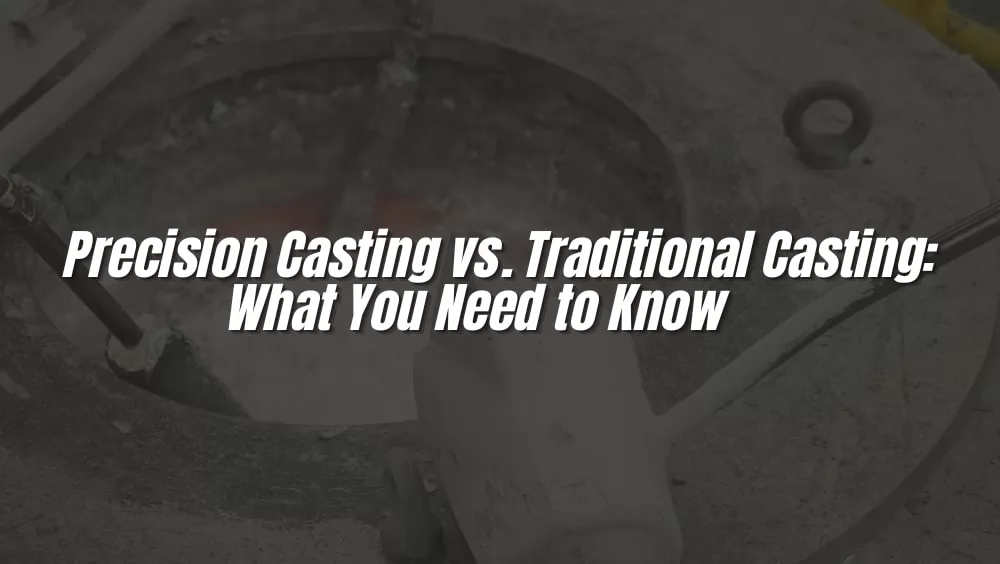
In modern manufacturing, choosing the right casting method can make or break the quality, cost-effectiveness, and efficiency of your project. Two of the most commonly used casting methods are precision casting and traditional casting. Understanding the differences, benefits, and limitations of each can help you make better decisions for your production needs.
This guide will break down everything you need to know.
Table of Contents
- What Is Precision Casting?
- What Is Traditional Casting?
- Key Differences Between Precision Casting and Traditional Casting
- Pros and Cons of Precision Casting
- Pros and Cons of Traditional Casting
- How to Choose the Right Casting Method for Your Project
- Future Trends in Casting Technology
- Conclusion
What Is Precision Casting?
Precision casting, also known as investment casting or lost-wax casting, is a highly accurate metal forming technique used to produce intricate and detailed components. The process typically involves:
- Creating a wax pattern – a replica of the final product.
- Building a ceramic shell around the wax model.
- Melting out the wax to leave a precise mold cavity.
- Pouring molten metal into the cavity.
- Breaking the shell to reveal the final casting.
This method allows manufacturers to achieve tight tolerances, thin walls, and smooth surface finishes without excessive machining.
Common Applications:
- Aerospace engine parts
- Gas turbines
- Precision medical equipment
- Automotive components requiring complex geometries
What Is Traditional Casting?
Here’s how these two methods stack up:
Traditional casting methods—like sand casting, die casting, and permanent mold casting—have been used for centuries. The most common, sand casting, involves:
- Packing sand around a pattern to create a mold cavity.
- Removing the pattern.
- Pouring molten metal into the cavity.
- Breaking the mold to retrieve the casting.
Traditional casting is well-suited for producing larger parts with less emphasis on ultra-tight tolerances.
Common Applications:
- Engine blocks and large machinery parts
- Heavy equipment housings
- Pipes and fittings
- Basic industrial components
Key Differences Between Precision Casting and Traditional Casting
| Aspect | Precision Casting | Traditional Casting |
|---|---|---|
| Accuracy | High dimensional precision | Lower precision |
| Surface Finish | Smooth, minimal machining needed | Rougher, requires more finishing |
| Cost | Higher per unit, lower waste | Lower per unit for large runs |
| Production Volume | Suitable for small to medium batches | Best for large volume |
| Design Flexibility | Complex, detailed geometries | Limited by mold material |
| Size Capability | Ideal for small to medium parts | Best for larger parts |
Accuracy
Precision casting delivers high dimensional accuracy for tight tolerances and detailed parts. Traditional casting has lower precision and suits parts where exact specs are less critical.
Surface Finish
Precision casting produces smooth surfaces with minimal machining needed. Traditional casting usually results in a rougher finish that needs extra work.
Cost
Precision casting costs more per unit but generates less waste. Traditional casting is cheaper for large production runs.
Production Volume
Precision casting works best for small to medium batches. Traditional casting is ideal for large-volume production.
Design Flexibility
Precision casting handles complex shapes and fine details. Traditional casting is more limited by the mold material.
Size Capability
Precision casting is best for small to medium parts. Traditional casting handles larger, heavy-duty parts well.
Pros and Cons of Precision Casting

Advantages
-
Exceptional accuracy and repeatability
Precision casting offers extremely high dimensional accuracy, making it ideal for parts that require tight tolerances. The process is highly repeatable, ensuring consistent quality across batches. -
Ability to cast complex and thin-walled parts
This method allows manufacturers to produce intricate shapes and very thin walls that other casting processes struggle to achieve. It’s perfect for detailed components with complex geometries. -
Excellent surface finish reduces post-processing
Parts produced by precision casting have smooth surfaces, which significantly reduces the need for additional machining or finishing. This saves both time and manufacturing costs. -
Material savings with minimal waste
Because the process uses precise molds and efficient techniques, material waste is kept to a minimum. This makes precision casting more sustainable and cost-effective in terms of raw material usage.
Disadvantages
-
Higher cost for molds and materials
Creating the molds and wax patterns for precision casting can be expensive, especially for small production runs. The cost of specialized materials also contributes to the higher upfront investment. -
Longer production cycle
The multiple steps involved—wax pattern creation, shell building, and wax removal—make the production cycle longer compared to traditional casting. This can delay turnaround times. -
Less economical for very large parts or high-volume runs
While great for small and medium-sized parts, precision casting becomes less cost-effective for very large components or mass production. Traditional casting methods are often preferred in those cases.
Pros and Cons of Traditional Casting

Advantages
-
Cost-effective for high-volume production
Traditional casting is economical when producing large quantities of parts. The lower cost per unit makes it ideal for mass production. -
Suitable for large, heavy parts
This method can easily handle the casting of large and heavy components. It is often used in industries requiring robust parts. -
Simpler and faster mold preparation for basic shapes
Mold creation for traditional casting is relatively straightforward and quick, especially for simpler geometries. This speeds up the initial setup process. -
Flexible material choices
Traditional casting can accommodate a wide variety of metals and alloys. This versatility supports many different applications.
Disadvantages
-
Lower dimensional accuracy
Traditional casting typically results in parts with less precise dimensions. This can limit their use in applications needing tight tolerances. -
Rougher surface finish
The surface texture of parts made by traditional casting is usually rougher. Additional machining is often necessary to improve appearance and fit. -
More post-casting machining required
Due to lower accuracy and surface finish, parts frequently require extensive machining after casting. This adds time and cost to production. -
Less suited for highly complex geometries
Traditional casting struggles with very intricate or thin-walled designs. It is better suited for simpler shapes.
How to Choose the Right Casting Method
Selecting between precision casting and traditional casting depends on several factors:
Complexity of Design
If your component has intricate details, thin walls, or tight tolerances, precision casting is the better choice.
Part Size
Larger parts often make more sense with traditional casting, especially sand casting.
Production Volume
For mass production of simple parts, traditional casting offers lower per-unit costs.
Budget and Lead Time
Precision casting tends to have higher upfront costs and longer lead times but can reduce costs later by minimizing machining.
Mechanical Performance
Some applications require the superior integrity and material properties achievable with precision casting.
When in doubt, consulting with an experienced foundry can help you weigh your priorities and select the right process.
Future Trends in Casting Technology

The foundry industry is evolving with advancements like additive manufacturing, which uses 3D printing to create wax patterns for investment casting. This innovation shortens lead times, improves precision, and offers greater design flexibility compared to traditional methods.
In addition, automation, robotics, and AI-driven process control are enhancing quality and minimizing human error. Sustainable practices are also gaining traction, with more foundries adopting recycled materials, energy-efficient furnaces, and environmentally friendly binders to reduce their environmental impact.
Conclusion
Both precision casting and traditional casting have their unique advantages and limitations. The right choice depends on your specific project requirements — from design complexity and production volume to budget constraints and performance needs.
By understanding these core differences, you can make informed decisions that help you deliver high-quality, cost-effective parts every time.
Looking for expert guidance and reliable manufacturing partners?
Besser is an industry leader with years of experience in both precision casting and traditional casting solutions. With a commitment to quality, advanced technology, and customer satisfaction, Besser can help you choose the right process, optimize your design, and bring your project to life efficiently.
Related Recommendations:
Top 10 Investment Casting Manufacturers & Suppliers in China
Best 10 Metal Casting Manufacturers and Suppliers
Top 10 Lost Wax Casting Companies: Latest List
How to source precision castings from China?
Best 10 Metal Casting Companies in the World



